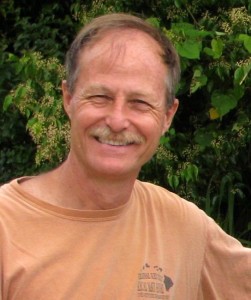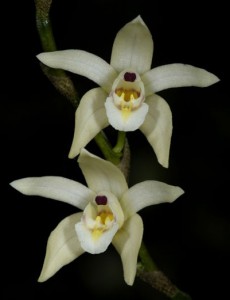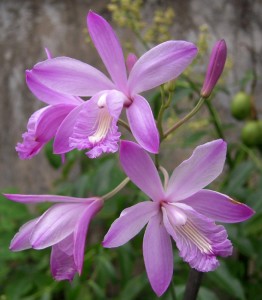Ackerman’s Orchids: Studying—and Sometimes Growing—Some Stars of the Plant World
Posted in Personalities in Science on April 15, 2014 by Stevenson Swanson
Stevenson Swanson is The New York Botanical Garden’s Science Media Manager.
 From the crowds that attend The New York Botanical Garden’s annual orchid exhibition, it’s clear that this family of flowering plants exerts a fascination on gardeners and plant lovers almost without equal in the horticultural world.
From the crowds that attend The New York Botanical Garden’s annual orchid exhibition, it’s clear that this family of flowering plants exerts a fascination on gardeners and plant lovers almost without equal in the horticultural world.
Count Prof. James D. Ackerman among the devotees. From his days as a graduate student in northern California, he’s devoted his scientific career to the study of Orchidaceae. Prof. Ackerman, who teaches biology at the University of Puerto Rico, is the lead author of Orchid Flora of the Greater Antilles, recently published by NYBG Press.
With full scientific treatments of 594 orchid species, the book covers the largest islands in the West Indies, including Cuba, Jamaica, Puerto Rico, and Hispaniola, the island that comprises the Dominican Republic and Haiti.
I had a chance to chat with Prof. Ackerman during his recent visit to the Botanical Garden, where he gave a talk about his time in the field cataloging the orchids of the Greater Antilles. He was also planning to see The Orchid Show: Key West Contemporary, which closes next Monday, April 21.
It’s safe to say most orchid fans admire the flowers for their beauty but don’t devote their lives to studying them the way you have. What led you to specialize in the science of orchids?

My grandfather was an orchid grower. He was a professor of entomology at the University of Hawaii, and when I was seven or eight years old, he would have me weed his orchid beds. My friends and I would brag to each other about orchids. Instead of “my dad is better than your dad,” it was more like, “my grandfather’s orchids are better than your dad’s orchids.”
Later, when I was at Humboldt State University, the greenhouse there had orchids for sale. They were very cheap, even for an undergraduate. I thought, “Well my grandfather grew orchids; I think I will, too.” So I went foraging in the library for books about how to grow orchids, but I also found books about the science of orchids, and that’s when I got hooked. These flowers are so cool. It was really the pollination of orchids that got me into it. I haven’t looked back since. I became very focused on trying to learn as much as I could about orchids.
Did you and your collaborators spend a lot of time in the field in the course of researching this orchid flora?
I went on field trips to the Dominican Republic, Cuba, and Jamaica. My colleagues also made field trips.
I told my colleagues: “Collect everything. If you see it in one place and you see it again, collect it again.” It was important to do that to fill in some of the gaps in what we knew about the distribution of certain species. Of course, we had permits to do all of this collecting.
I also had to spend time in Cuban herbaria because they don’t send out their specimens. The Dominican Republic is reluctant to send specimens as well. A big chunk of time was spent sitting in a herbarium, going through collections.
Speaking of herbaria, what role did the William and Lynda Steere Herbarium play in your research?

The Steere Herbarium has the best, most diverse collection of West Indian plants, covering all three major island groups—the Greater and Lesser Antilles and the Bahamas.
In the early 20th century, [Garden founder Nathaniel Lord] Britton collected heavily in the West Indies—the Bahamas, and also Cuba and Puerto Rico in the Greater Antilles.
In fact, the names of famous scientists are engraved on the front of the old biology building at the University of Puerto Rico: Linnaeus, Darwin, Mendel, a couple of other guys—and Britton. He played an important role in the development of the university. There’s a historical and intimate relationship between the Garden and the University of Puerto Rico.
Having surveyed the largest islands in the Caribbean, how well or poorly would you say orchids are holding up in the wild there?
The interesting thing about the Antilles is that they are subjected to hurricanes, and very frequently in terms of evolutionary time. The vegetation gets knocked down a lot, but things are adapted to those conditions. They come back. They may not come back in the same place in the same way, but they come back.
The orchid flora is very resilient. However, there are real threats. We’re not talking about hurricanes but big machines going in to mine nickel and chromium. That had been a big issue in Cuba. And aluminum in Hispaniola and in Jamaica, too. Mining isn’t as extensive as it used to be, but anywhere where there’s strip mining, it’s awful. And where they do the strip mining, they’re orchid-rich areas, with locally concentrated species. That’s true not just of orchids but of a lot of components of the vegetation.
Tourism development is a problem, but not such a big one for orchids. The focus of that development is near the seashore, of course, but not many orchid species occur near the shore.
Are there any trends or developments that give you hope about the survival of wild orchids in the region?
One of the best things about Cuba is that there’s really no orchid trade. In fact, because of CITES, things have slowed down a lot in the orchid trade. [CITES is an international treaty that bans trades in endangered species.]
Particularly in Hispaniola, they have set aside a lot of national parks. Some are very well protected and some are not. But they have made an effort there, which is fabulous.
What about your home for the last 33 years, Puerto Rico?
It’s a matter of containing the urban sprawl. There’s a lot of concrete and asphalt, and so the most immediate problem is the heating that results from the sprawl. That could put in danger the species that grow at the top of cloud forests because as the temperature rises, the cloud layer moves up the mountains and the plants that are exposed dry out.
And then there are the new orchids that have arrived from Asia. Those are the invaders. I was able to show that populations of one invasive have led to an increase in the population of a weevil that damages Bletia patula, a native orchid [see photo above] whose fruit and seed production have declined.
The best thing about Puerto Rico is that the conservation lobby is stronger than it has ever been.
So after all of these years of studying orchids, are you still also an orchid grower?
You might say I’m a Darwinian grower. If someone gives me an orchid, I stick it up in a tree. If it survives, it survives. If it doesn’t, it doesn’t.
For more about Orchid Flora of the Greater Antilles, read the press release here.
For ordering information, go to nybgpress.org.

